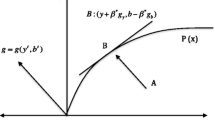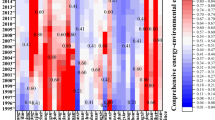Abstract
With the process of agricultural modernization, energy consumption in China’s agriculture has increased significantly these years. Based on this context, this study tries to investigate the rebound effect of China's agricultural energy consumption, and how the popularization of agricultural machinery impacts on energy rebound rate. Elasticity analysis and data envelopment analysis based on meta-frontier are used to conduct the research, which can make the energy rebound rate more accurate compared with previous studies. Some important findings are obtained based on these methods. First, it confirms that the energy consumption in China’s agricultural sector has significant rebound effect due to technical progress, which averages 0.7215 in short term and 0.5283 in long term. This indicates that the improvement of energy efficiency can only achieve 27.85 and 47.17% of the expected energy-saving target in the short and long term. Second, there is a distinct difference in energy rebound rate in China’s different regions, the eastern area has been always far ahead of central and western regions, which implies that it is more difficult for eastern region to achieve energy saving relying on technological progress. Third, the population of mechanization increased the energy rebound rate by 0.0002 temporarily and 0.0004 permanently in the research sample. Based on these research results, some important policy implications are recommended to reduce energy rebound rate for China’s agricultural sector.




Similar content being viewed by others
Abbreviations
- \(E_{it}^{*}\) :
-
Optimal energy consumption
- \(P_{it}\) :
-
Energy price
- \(\tau_{it}\) :
-
Energy efficiency
- \(\sigma_{\tau ,it}^{\rm st}\) :
-
Short-term energy elasticity
- \(\sigma_{\tau ,it}^{\rm lt}\) :
-
Long-term energy elasticity
- SRe:
-
Short-term rebound effect
- LRe:
-
Long-term rebound effect
- CGE:
-
Computable general equilibrium
- GTFEE:
-
Energy efficiency based on group frontier
- MTFEE:
-
Energy efficiency based on meta-frontier
- DEA:
-
Data envelopment analysis
- GMM:
-
Generalized method of moments
References
Adetutu MO, Glass AJ, Weyman-Jones TG (2016) Decomposing energy demand across BRIIC countries. Energy Econ 54:396–404
Adeyemi OI, Broadstock DC, Chitnis M, Hunt LC, Judge G (2010) Asymmetric price responses and the underlying energy demand trend: Are they substitutes or complements? Evidence from modelling OECD aggregate energy demand. Energy Econ 32:1157–1164
Adofo YO, Evans J, Hunt LC (2013) How sensitive to time period sampling is the asymmetric price response specification in energy demand modelling? Energy Econ 40:90–109
Arellano M, Bond S (1991) Some test of specification for panel data: Monte Carlo evidence and an application to employment equations. Rev Econ Stud 1:277–297
Bentzen J (2004) Estimating the rebound effect in US manufacturing energy consumption. Energy Econ 26:123–134
Blundell R, Bond S (1998) GMM estimation with persistent panel data: an application to production functions. J Econom 87:15–143
Boufateh T (2019) The environmental Kuznets curve by considering asymmetric oil price shocks: evidence from the top two. Environ Sci Pollut R 26:706–720
Chitnis M, Sorrell S, Druckman A, Firth SK, Jackson T (2013) Turning lights into flights: estimating direct and indirect rebound effects for UK households. Energy Policy 55:234–250
Du KR, Li JL (2019) Towards a green world: How do green technology innovations affect total-factor carbon productivity. Energy Policy 131:240–250
Du KR, Li PZ, Yan ZM (2019a) Do green technology innovations contribute to carbon dioxide emission reduction? Empirical evidence from patent data. Technol Forecast Soc 146:297–303
Du Q, Li Z, Li Y, Bai LB, Li JT, Han X (2019b) Rebound effect of energy efficiency in China’s construction industry: a general equilibrium analysis. Environ Sci Pollut R 26:12217–12226
Dumagan JC, Mount TD (1993) Welfare effects of improving end-use efficiency: theory and application to residential electricity demand. Resour Energy Econ 15:175–201
Fan RG, Luo M, Zhang PF (2016) A study on evolution of energy intensity in China with heterogeneity and rebound effect. Energy 99:159–169
Figus G, McGregor PG, Swales JK, Turner K (2020) Do sticky energy prices impact the time paths of rebound effects associated with energy efficiency actions? Energy Economics 86
Freire-Gonzalez J, Vivanco DF (2017) The influence of energy efficiency on other natural resources use: An input-output perspective. J Clean Prod 162:336–345
Greening LA, Greene DL, Difiglio C (2000) Energy efficiency and consumption: the rebound effect—a survey. Energy Policy 28:389–401
Haas R, Biermayr P (2000) The rebound effect for space heating: Empirical evidence from Austria. Energy Policy 28:403–410
Hediger C, Farsi M, Weber S (2018) Turn it up and open the window: on the rebound effects in residential heating. Ecol Econ 149:21–39
Hotelling H (1991) The economics of exhaustible resources (reprinted from journal of political-economy, vol 39, pg 137–175, 1931). B Math Biol 53:281–312
Jevons WS (1866) The coal question; an enquiry concerning the progress of the Nation, and the probable exhaustion of our coal-mines. Macmillan, London,, xxvi, 383 p. incl. front. (diagr.) pp
Jin SH (2007) The effectiveness of energy efficiency improvement in a developing country: rebound effect of residential electricity use in South Korea. Energy Policy 35:5622–5629
Khazzoom JD (1980) Economic implications of mandated efficiency in standards for household appliances. Energ J 1(4):21–40
Li JL, Liu HX, Du KR (2019) Does market-oriented reform increase energy rebound effect? Evidence from China’s regional development, China Econ Rev, p 56
Li K, Zhang N, Liu YC (2016) The energy rebound effects across China’s industrial sectors: an output distance function approach. Appl Energ 184:1165–1175
Lin BQ, Zhao HL (2016) Technological progress and energy rebound effect in China’s textile industry: evidence and policy implications. Renew Sust Energ Rev 60:173–181
Madlener R, Alcott B (2009) Energy rebound and economic growth: a review of the main issues and research needs. Energy 34:370–376
Matos FJF, Silva FJF (2011) The rebound effect on road freight transport: Empirical evidence from Portugal. Energy Policy 39:2833–2841
Meyerding S (2016) Energy efficiency and environmental sustainability - the rebound effect in horticultural enterprises. Ber Landwirtsch 94
Ouyang XL, Li Q, Du KR (2020) How does environmental regulation promote technological innovations in the industrial sector? Evidence from Chinese provincial panel data. Energy Policy 139
Roy J (2000) The rebound effect: some empirical evidence from India. Energ Policy 28:433–438
Saunders H (1992) The Khazzoom-Brookes postulate and neoclassical growth. Energ J 13(4):131–148
Saunders HD (2013) Historical evidence for energy efficiency rebound in 30 US sectors and a toolkit for rebound analysts. Technol Forecast Soc 80:1317–1330
Schipper L, Grubb M (2000) On the rebound? Feedback between energy intensities and energy uses in IEA countries. Energy Policy 28:367–388
Sek SK (2019) Unveiling the factors of oil versus non-oil sources in affecting the global commodity prices: a combination of threshold and asymmetric modeling approach. Energy 176:272–280
Shao S, Huang T, Yang LL (2014) Using latent variable approach to estimate China’s economy-wide energy rebound effect over 1954–2010. Energ Policy 72:235–248
Sorrell S, Dimitropoulos J (2008) The rebound effect: Microeconomic definitions, limitations and extensions. Ecol Econ 65:636–649
Steren A, Rubin OD, Rosenzweig S (2016) Assessing the rebound effect using a natural experiment setting: Evidence from the private transportation sector in Israel. Energy Policy 93:41–49
Thomas BA, Azevedo IL (2013) Estimating direct and indirect rebound effects for US households with input-output analysis. Part 2: Simulation. Ecol Econ 86:188–198
Veblen T (1899) The theory of the leisure class; an economic study in the evolution of institutions. The Macmillan company;Macmillan & co., ltd., New York,London,, viii, 400 p. pp
Yan ZM, Ouyang XL, Du KR (2019) Economy-wide estimates of energy rebound effect: evidence from China’s provinces. Energy Economics 83:389–401
Zhang YJ, Peng HR (2017) Exploring the direct rebound effect of residential electricity consumption: an empirical study in China. Appl Energ 196:132–141
Zhou MF, Liu Y, Feng SH, Liu Y, Lu YY (2018) Decomposition of rebound effect: an energy-specific, general equilibrium analysis in the context of China. Appl Energ 221:280–298
Acknowledgements
The authors are indebted to the anonymous referees and the editors for their valuable and constructive suggestions. The research was supported by the Chinese National Research of Social Sciences Youth funded projects (No. 19CGJ041) and Fundamental Research Funds for the Central Universities, China (No. 2019VI020).
Author information
Authors and Affiliations
Corresponding author
Additional information
Editorial responsibility: Q. Aguilar-Virgen.
Rights and permissions
About this article
Cite this article
Pan, A., Sun, Q., Wang, Q. et al. Energy rebound effect associated with energy efficiency: an application to China’s agricultural sector. Int. J. Environ. Sci. Technol. 18, 3819–3832 (2021). https://doi.org/10.1007/s13762-020-03085-1
Received:
Revised:
Accepted:
Published:
Issue Date:
DOI: https://doi.org/10.1007/s13762-020-03085-1




